Background
The term cellulitis is commonly used to indicate a nonnecrotizing inflammation of the skin and subcutaneous tissues, a process related to acute infection that does not involve the fascia or muscles and that is characterized by localized pain, swelling, tenderness, erythema, and warmth.
Cellulitis was classically considered to be an infection without formation of abscess and without purulent drainage or ulceration. In clinical practice, the division between cellulitis and abscess is not distinct. Frequently, the macular erythema of cellulitis coexists with nodules, areas of ulceration, and frank abscess formation (see Clinical Presentation). The following images illustrate some of these presentations.
Cellulitis was classically considered to be an infection without formation of abscess and without purulent drainage or ulceration. In clinical practice, the division between cellulitis and abscess is not distinct. Frequently, the macular erythema of cellulitis coexists with nodules, areas of ulceration, and frank abscess formation (see Clinical Presentation). The following images illustrate some of these presentations.
Media file 1: Mild cellulitis with a fine lacelike pattern of erythema. This lesion was only slightly warm and caused minimal pain, which is typical for the initial presentation of mild cellulitis.
Media file 2: Cellulitis involving the hand.
Media file 3: Severe cellulitis of the leg in a woman aged 80 years. The cellulitis developed beneath a cast and was painful and warm to the touch. Significant erythema is evident. The margins are irregular but not raised. An ulcerated area is visible in the center of the photograph.
Pathophysiology
Cellulitis usually follows a break in the skin, such as a fissure, cut, laceration, insect bite, or puncture wound. Organisms on the skin and its appendages gain entrance to the dermis and multiply to cause cellulitis. Facial cellulitis of odontogenic origin may also occur. However, cellulitis frequently occurs in areas where no apparent injury exists. This is common in dry and irritated skin where microscopic breaks allow penetration of bacteria. Patients with toe web intertrigo and/or tinea pedis and those with lymphatic obstruction, venous insufficiency, pressure ulcers, and obesity are particularly vulnerable to recurrent episodes of cellulitis.[1, 2, 3, 4]
The vast majority of cases are caused by Streptococcus pyogenes or Staphylococcus aureus. Occasionally, cellulitis may be caused by the emergence of subjacent osteomyelitis. Cellulitis may rarely result from the metastatic seeding of an organism from a distant focus of infection, especially in immunocompromised individuals. This is particularly common in cellulitis due to S pneumoniae (pneumococcus) and marine vibrios. Neisseria meningitidis, Pseudomonas aeruginosa, Brucella species, and Legionella species have also been reported as rare causes of cellulitis resulting from hematogenous spread.[5]
The vast majority of cases are caused by Streptococcus pyogenes or Staphylococcus aureus. Occasionally, cellulitis may be caused by the emergence of subjacent osteomyelitis. Cellulitis may rarely result from the metastatic seeding of an organism from a distant focus of infection, especially in immunocompromised individuals. This is particularly common in cellulitis due to S pneumoniae (pneumococcus) and marine vibrios. Neisseria meningitidis, Pseudomonas aeruginosa, Brucella species, and Legionella species have also been reported as rare causes of cellulitis resulting from hematogenous spread.[5]
Etiology
Host factors
Certain host factors predispose to severe infection. Individuals with comorbid conditions such as diabetes mellitus (frequently polymicrobial), immunodeficiency, cancer, venous stasis, chronic liver disease, peripheral arterial disease, chronic kidney disease, and other systemic disease appear to be at a higher risk for both recurrent and more severe infection, owing to an altered host immune response. Other factors that affect host immunity and predispose to cellulitis include concurrent intravenous (IV) or subcutaneous (SC) “skin popping” drug use; infections in this setting are most often polymicrobial, but community-associated methicillin-resistant S aureus (CA-MRSA) is also a common pathogen.
In individuals with normal host defenses, the most common causative organisms are group A streptococci (GAS) and S aureus. Group B Streptococcus cellulitis occurs in infants younger than 6 months, as their immune responses are not fully developed. The cellulitis may present as sepsis[6] ; underlying osteomyelitis or septic arthritis must be excluded in these infants. (See the image below.)
In individuals with normal host defenses, the most common causative organisms are group A streptococci (GAS) and S aureus. Group B Streptococcus cellulitis occurs in infants younger than 6 months, as their immune responses are not fully developed. The cellulitis may present as sepsis[6] ; underlying osteomyelitis or septic arthritis must be excluded in these infants. (See the image below.)
Media file 6. A case of cellulitis without associated purulence in an infant. Note the presence of lymphedema, a risk factor for cellulitis (Photo courtesy of Amy Williams).
In children, facial cellulitis is frequently associated with H influenzae type B and S pneumoniae; prophylactic pneumococcal vaccine may be effective in the latter cases. A study of one-half million pediatric hospitalizations demonstrated that, although bacterial meningitis and epiglottitis diminished as a result of immunization for H influenzae type B and S pneumoniae, the incidence of facial cellulitis was unaffected.[7] However, another study noted that 96% of the serotypes that cause facial cellulitis are included in the heptavalent-conjugated pneumococcal vaccine that is licensed in the United States.
Immunocompromised hosts typically become infected from opportunistic organisms, including gram-negative rods (eg, Pseudomonas, Proteus, Serratia, Enterobacter, Citrobacter), anaerobes, and others (eg, Helicobacter cinaedi, Fusarium species). Although fungi (eg, Cryptococcus) may also cause cellulitis, this is rare.
Pneumococci may cause a particularly malignant form of cellulitis that is frequently associated with tissue necrosis, suppuration, and bloodstream invasion. Two distinct syndromes are recognized: the first is marked by involvement of the extremities in patients with diabetes or substance abuse, and the second is marked by involvement of the head, neck, and upper torso in patients with systemic lupus erythematosus, nephrotic syndrome, or hematologic disorders.[8]
Mycobacterial infections may present as cellulitis. Typically, the lack of response to antibiotics prompts further investigation. The diagnosis is made based on the presence of granulomas, multinucleated giant cells, and acid-fast bacilli (AFB) from biopsy specimens.[9, 10, 11]
S aureus is the leading cause of soft-tissue infections in injection drug users,[12] followed by Streptococcus species.[13]
Gram-negative bacteria may cause bullous cellulitis in patients with cirrhosis.[14] Early recognition is vital, as the course of the disease is rapid, typically progressing to septic shock and death. Gram stain and culture of fluid aspirated from the bullae may aid in management.
Recurrent staphylococcal cellulitis may occur in patients with nasal carriage of staphylococci and those with Job syndrome.
Immunocompromised hosts typically become infected from opportunistic organisms, including gram-negative rods (eg, Pseudomonas, Proteus, Serratia, Enterobacter, Citrobacter), anaerobes, and others (eg, Helicobacter cinaedi, Fusarium species). Although fungi (eg, Cryptococcus) may also cause cellulitis, this is rare.
Pneumococci may cause a particularly malignant form of cellulitis that is frequently associated with tissue necrosis, suppuration, and bloodstream invasion. Two distinct syndromes are recognized: the first is marked by involvement of the extremities in patients with diabetes or substance abuse, and the second is marked by involvement of the head, neck, and upper torso in patients with systemic lupus erythematosus, nephrotic syndrome, or hematologic disorders.[8]
Mycobacterial infections may present as cellulitis. Typically, the lack of response to antibiotics prompts further investigation. The diagnosis is made based on the presence of granulomas, multinucleated giant cells, and acid-fast bacilli (AFB) from biopsy specimens.[9, 10, 11]
S aureus is the leading cause of soft-tissue infections in injection drug users,[12] followed by Streptococcus species.[13]
Gram-negative bacteria may cause bullous cellulitis in patients with cirrhosis.[14] Early recognition is vital, as the course of the disease is rapid, typically progressing to septic shock and death. Gram stain and culture of fluid aspirated from the bullae may aid in management.
Recurrent staphylococcal cellulitis may occur in patients with nasal carriage of staphylococci and those with Job syndrome.
Hospital-acquired infections
Various hospital-acquired infections following soft-tissue trauma may lead to cellulitis, such as those around surgical wounds less than 24 hours postoperatively (group A beta-hemolytic Streptococcus [GABHS] or Clostridium perfringens, which produces gas that may be appreciated as crepitus on examination) or from gunshot wounds or invasive devices (Acinetobacter baumannii is an emerging multidrug-resistant pathogen in these scenarios.)[15]
Cellulitis due to lymphatic obstruction or venectomy is generally caused by non–group A streptococci (ie, groups B, C, and G).[16, 17] Postvenectomy status following saphenous vein stripping can also result in cellulitis[16] and is associated with tinea pedis; culture of toe web spaces may assist in identifying a bacterial pathogen.[18] Lymphadenectomy following tumor excision, such as mastectomy, is also a predisposing factor for cellulitis.
Cellulitis due to lymphatic obstruction or venectomy is generally caused by non–group A streptococci (ie, groups B, C, and G).[16, 17] Postvenectomy status following saphenous vein stripping can also result in cellulitis[16] and is associated with tinea pedis; culture of toe web spaces may assist in identifying a bacterial pathogen.[18] Lymphadenectomy following tumor excision, such as mastectomy, is also a predisposing factor for cellulitis.
Varicella
Cellulitis can complicate varicella and may be identified by a margin of erythema surrounding the vesicles. In one study, patients with invasive GAS cellulitis complicating varicella were identified.[19] The median onset of GAS infection was day 4 of varicella, with fever, vomiting, and localized swelling reported.[19] This condition mandates antibiotic treatment and careful clinical follow-up. Untreated cellulitis in association with varicella may progress to severe necrotizing soft-tissue infections requiring surgical intervention.[20]
MRSA
Cellulitis can be complicated by abscess formation. A maxim in microbiology states, "The hallmark of staph infection is abscess formation." This has become a significant concern due to changing patterns of antibiotic resistance in S aureus, particularly MRSA.[21]
MRSA was first reported in 1968[22] ; for years, MRSA infections were identified only in patients with recent hospitalization, surgery, renal dialysis, residence in long-term-care facilities, or IV drug use. However, in recent years, isolates of S aureus have been found in patients without risk factors for nosocomial disease.[23] These isolates have been termed CA-MRSA to distinguish them from the previously identified hospital or healthcare-associated MRSA (HA-MRSA). (See the images below.)
Although reports have indicated that MRSA causes the majority of skin and soft-tissue infections (SSTIs), these studies are plagued by variability in case-finding methodologies.[24] Furthermore, in the context of cellulitis, the finding is misleading in that these reports come from analysis of wound cultures in cases in which abscess formation occurred. Cultures in cellulitis are difficult to perform and are infrequently done. Therefore, the results of these studies cannot be generalized to cellulitis without abscess formation. Studies are under way to determine the incidence of S aureus —in particular, CA-MRSA in soft-tissue infection in which there is no identifiable abscess. However, until results of those studies are available, treatment decisions must be made on clinical grounds.
MRSA was first reported in 1968[22] ; for years, MRSA infections were identified only in patients with recent hospitalization, surgery, renal dialysis, residence in long-term-care facilities, or IV drug use. However, in recent years, isolates of S aureus have been found in patients without risk factors for nosocomial disease.[23] These isolates have been termed CA-MRSA to distinguish them from the previously identified hospital or healthcare-associated MRSA (HA-MRSA). (See the images below.)
Although reports have indicated that MRSA causes the majority of skin and soft-tissue infections (SSTIs), these studies are plagued by variability in case-finding methodologies.[24] Furthermore, in the context of cellulitis, the finding is misleading in that these reports come from analysis of wound cultures in cases in which abscess formation occurred. Cultures in cellulitis are difficult to perform and are infrequently done. Therefore, the results of these studies cannot be generalized to cellulitis without abscess formation. Studies are under way to determine the incidence of S aureus —in particular, CA-MRSA in soft-tissue infection in which there is no identifiable abscess. However, until results of those studies are available, treatment decisions must be made on clinical grounds.
Media file 7. Patient with cellulitis of the left ankle. Note the area of drainage. This cellulitis was caused by community-acquired methicillin-resistant Staphylococcus aureus (CA-MRSA). (Photo courtesy of Texas Dept. of Public Health)
Media file 8. Abscess and associated cellulitis caused by community-acquired methicillin-resistant Staphylococcus aureus (CA-MRSA). (Photo courtesy of Texas Dept. of Public Health)
Bite wounds, lacerations, and puncture wounds
Mammalian bite wounds represent a specific subset of cellulitis with unique pathogens. The infections are usually polymicrobial.[25] Human, dog, cat, and wild-animal bites all predispose to cellulitis with unique pathogens, but dogs are the most commonly encountered bite wound in both the primary care and emergency setting.[26] Several organisms are of particular interest in animal bites, including the following[25] :
Capnocytophaga canimorsus (dog)
Eikenella corrodens (human)
Pasteurella multocida (dog or cat)
Streptobacillus moniliformis (rat)
Puncture wounds, especially through the bottom of athletic shoes, may cause Pseudomonas osteomyelitis and/or cellulitis. However, lacerations and puncture wounds sustained in an aquatic environment (eg, oceans, lakes, streams) may be contaminated with bacteria not typically found in land-based injuries, including Aeromonas hydrophila, Pseudomonas and Plesiomonas species, Vibrio species, Erysipelothrix rhusiopathiae, Mycobacterium marinum, and others.[27] Individuals with chronic liver disease are particularly susceptible to V vulnificus infections (see the image below).[28]
Capnocytophaga canimorsus (dog)
Eikenella corrodens (human)
Pasteurella multocida (dog or cat)
Streptobacillus moniliformis (rat)
Puncture wounds, especially through the bottom of athletic shoes, may cause Pseudomonas osteomyelitis and/or cellulitis. However, lacerations and puncture wounds sustained in an aquatic environment (eg, oceans, lakes, streams) may be contaminated with bacteria not typically found in land-based injuries, including Aeromonas hydrophila, Pseudomonas and Plesiomonas species, Vibrio species, Erysipelothrix rhusiopathiae, Mycobacterium marinum, and others.[27] Individuals with chronic liver disease are particularly susceptible to V vulnificus infections (see the image below).[28]
Media file 5. Cellulitis due to documented Vibrio vulnificus infection. Image courtesy of Kepler Davis.
Epidemiology
Because cellulitis is not a reportable disease, the exact prevalence is uncertain; however, it is a relatively common infection, affecting all racial and ethnic groups. There is no statistically significant difference in the incidence of cellulitis in men and women,[29] and no age predilection is usually described. However, studies have found a higher incidence of cellulitis in general among individuals older than 45 years.[2, 30, 31] Cellulitis was found to be more common in geriatric patients in a retrospective study of international travelers by the GeoSentinel Surveillance Network.[32]
Certain age groups are at a higher risk in some unique scenarios, such as the following:
Historically, buccal cellulitis caused by H influenzae type B was more common in children younger than age 3 years. Vaccination against this organism may have decreased the incidence of buccal cellulitis, but recent data suggest that this source remains a consideration, even in vaccinated cohorts.[7]
Facial cellulitis is more common in adults older than 50 years. However, pneumococcal facial cellulitis occurs primarily in young children who are at risk for pneumococcal bacteremia.[8, 33]
Perianal cellulitis, usually with GABHS, occurs in children younger than 3 years.[34]
Elderly patients with cellulitis are predisposed to thrombophlebitis.
A 2006 study of an insurance database in Utah found an incidence rate of 24.6 cases per 1000 person-years. The incidence was noted to be higher in males and in those individuals aged 45-64 years.[30] In a large epidemiologic hospital-based study on skin, soft-tissue, bone, and joint infections, 37.3% patients were identified as having cellulitis.[35]
Overall rates of visits increased for skin and soft-tissue infections (SSTIs) from 32.1 to 48.1 visits per 1000 population and reached 14.2 million by 2005, and visits for abscess and cellulitis increased from 17.3 to 32.5 visits per 1000 population and accounted for more than 95% of the increase, according to the National Ambulatory Medical Care Survey and National Hospital Ambulatory Medical Care Survey. The study provided data regarding visits by patients with SSTIs to physician offices, hospital outpatient departments, and emergency departments in the United States.[36]
Cellulitis was found to account for approximately 3% of emergency medical consultations at one United Kingdom district general hospital.
Certain age groups are at a higher risk in some unique scenarios, such as the following:
Historically, buccal cellulitis caused by H influenzae type B was more common in children younger than age 3 years. Vaccination against this organism may have decreased the incidence of buccal cellulitis, but recent data suggest that this source remains a consideration, even in vaccinated cohorts.[7]
Facial cellulitis is more common in adults older than 50 years. However, pneumococcal facial cellulitis occurs primarily in young children who are at risk for pneumococcal bacteremia.[8, 33]
Perianal cellulitis, usually with GABHS, occurs in children younger than 3 years.[34]
Elderly patients with cellulitis are predisposed to thrombophlebitis.
A 2006 study of an insurance database in Utah found an incidence rate of 24.6 cases per 1000 person-years. The incidence was noted to be higher in males and in those individuals aged 45-64 years.[30] In a large epidemiologic hospital-based study on skin, soft-tissue, bone, and joint infections, 37.3% patients were identified as having cellulitis.[35]
Overall rates of visits increased for skin and soft-tissue infections (SSTIs) from 32.1 to 48.1 visits per 1000 population and reached 14.2 million by 2005, and visits for abscess and cellulitis increased from 17.3 to 32.5 visits per 1000 population and accounted for more than 95% of the increase, according to the National Ambulatory Medical Care Survey and National Hospital Ambulatory Medical Care Survey. The study provided data regarding visits by patients with SSTIs to physician offices, hospital outpatient departments, and emergency departments in the United States.[36]
Cellulitis was found to account for approximately 3% of emergency medical consultations at one United Kingdom district general hospital.
Prognosis
The vast majority of cellulitis and soft-tissue infections can be treated on an outpatient basis with oral antibiotics and do not result in lasting sequelae. Most patients’ conditions respond well to standard oral antibiotics. When outpatient therapy is unsuccessful and for patients who require admission initially, IV antibiotics are usually effective.
Because cellulitis may progress to serious illness by uncontrolled contiguous spread or via the lymphatic or circulatory systems, complications include lymphangitis, abscess formation, gangrenous cellulitis, and necrotizing fasciitis.[37] Certain strains of bacteria, most notably group A beta-hemolytic Streptococcus (GABHS) and S aureus, produce toxins that may mediate a more severe systemic infection, leading to septic shock and death.
Because cellulitis may progress to serious illness by uncontrolled contiguous spread or via the lymphatic or circulatory systems, complications include lymphangitis, abscess formation, gangrenous cellulitis, and necrotizing fasciitis.[37] Certain strains of bacteria, most notably group A beta-hemolytic Streptococcus (GABHS) and S aureus, produce toxins that may mediate a more severe systemic infection, leading to septic shock and death.
Patient Education
Depending on the location of the affected area, the patient may want to decrease physical activity and elevate the extremity, if possible. They may take over-the-counter (OTC) pain medication such as acetaminophen (Tylenol) or ibuprofen (Advil, Motrin) for pain, if approved by their physician.
Patients should call their doctor's office immediately if they have any of the following features:
Fever (>100.5°F), especially when associated with chills
Cellulitis with soft, fluctuant areas suggestive of abscess formation
A red streak from an area of cellulitis or a fast-spreading area of redness, which indicates that the infection may need a different antibiotic or an IV antibiotic
Significant pain not relieved by acetaminophen or ibuprofen
Inability to move an extremity or joint because of pain
Patients with diabetes, cancer, or immunosuppression should be made aware that localized cellulitis may become serious.
For additional patient education resources, visit eMedicine's Diabetes Center. Also, see eMedicine's patient education article Cellulitis
Patients should call their doctor's office immediately if they have any of the following features:
Fever (>100.5°F), especially when associated with chills
Cellulitis with soft, fluctuant areas suggestive of abscess formation
A red streak from an area of cellulitis or a fast-spreading area of redness, which indicates that the infection may need a different antibiotic or an IV antibiotic
Significant pain not relieved by acetaminophen or ibuprofen
Inability to move an extremity or joint because of pain
Patients with diabetes, cancer, or immunosuppression should be made aware that localized cellulitis may become serious.
For additional patient education resources, visit eMedicine's Diabetes Center. Also, see eMedicine's patient education article Cellulitis

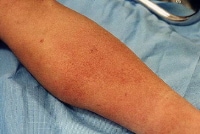

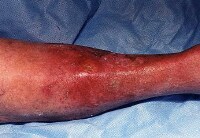

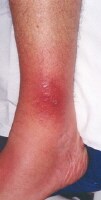
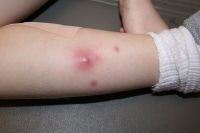
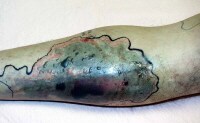
ليست هناك تعليقات:
إرسال تعليق